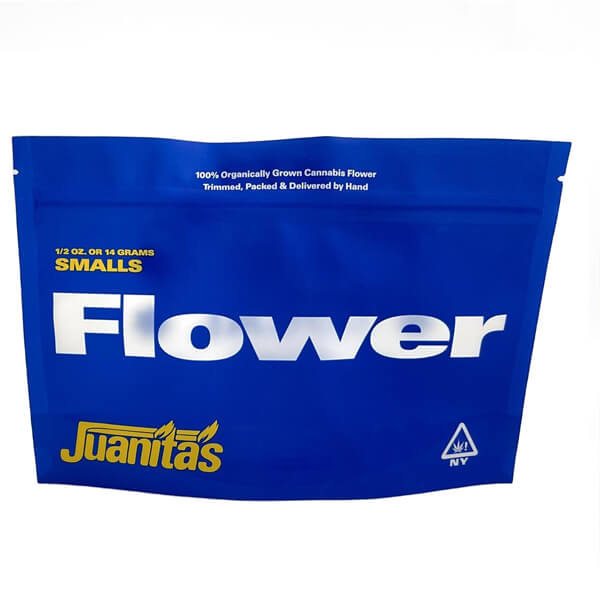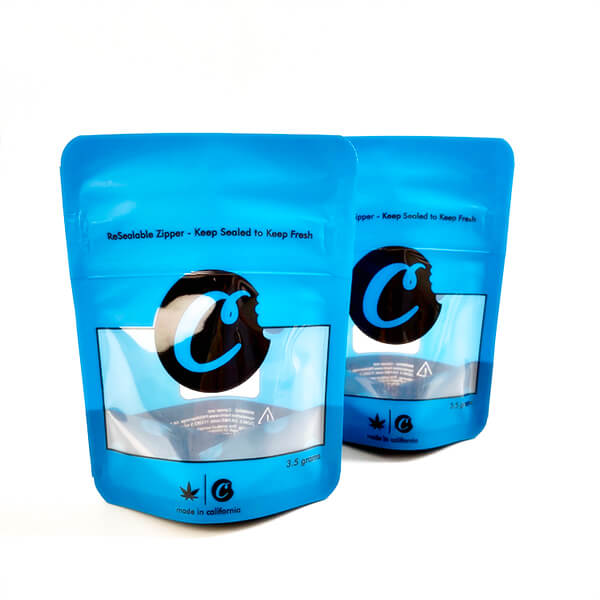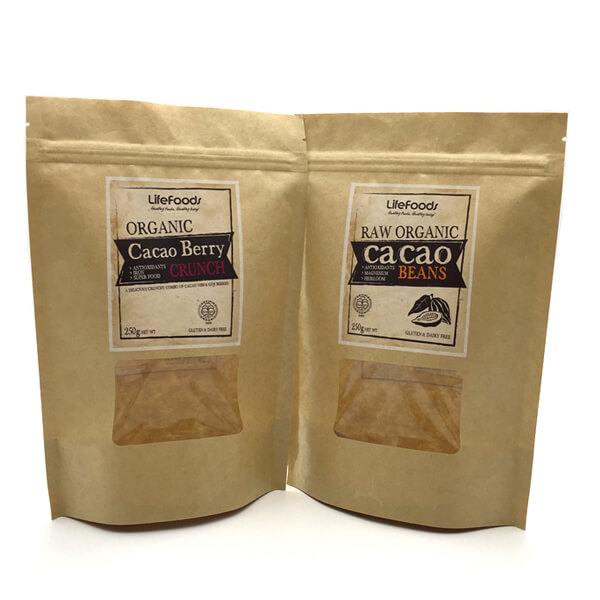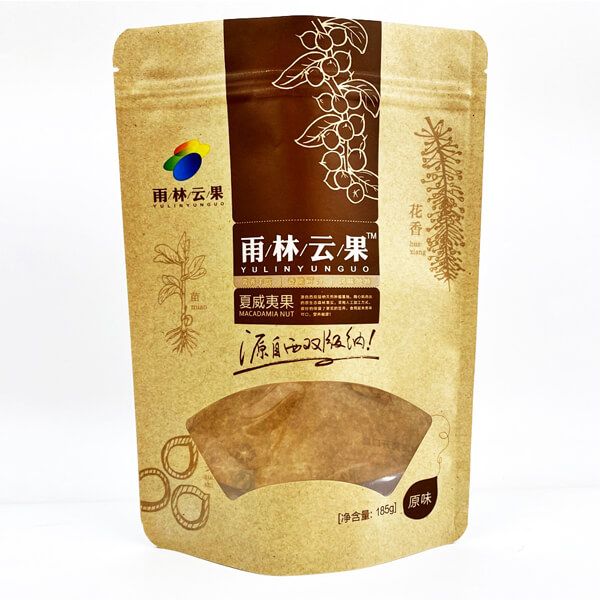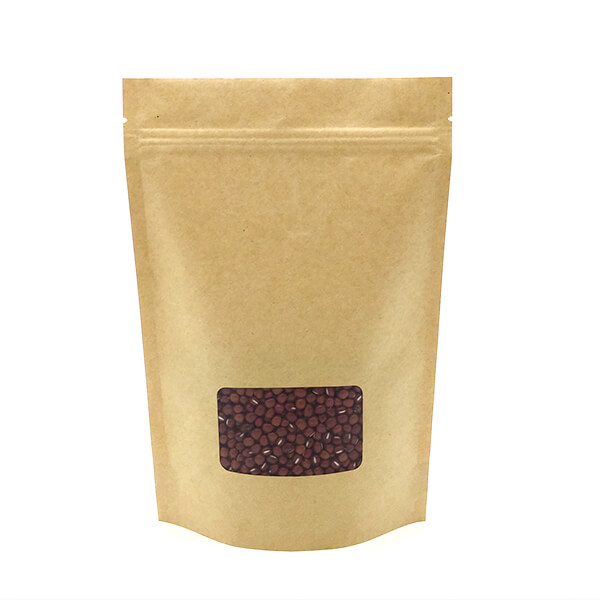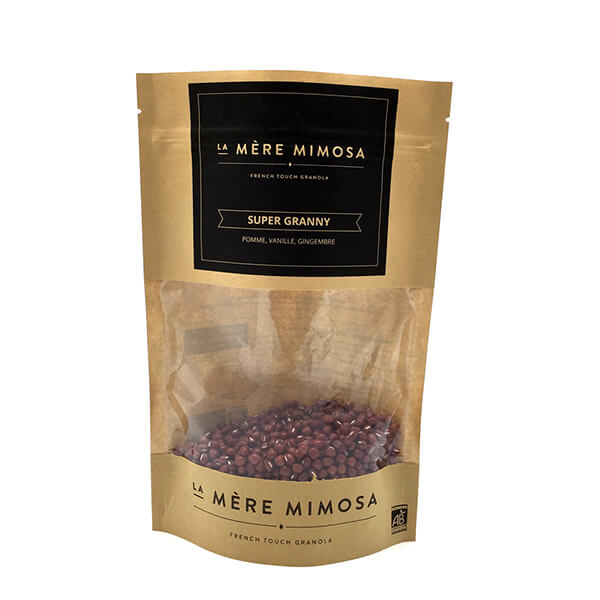Home » Bags & Pouches » Window Pouches » Window Pouches For Food
Window Pouches For Food
Window pouches for food packaging stand up on their own and feature a window to allow your customer to peek inside the bag and view the product. The bag has medium storage properties and can adequately protect the contents from external influences.
Please note that we have a MOQ for our pouch. For pouches in stock, the MOQ is 500 pcs. For customized pouches, please see the MOQ as followed:
1, Digital Printing — 500 pcs
2, Gravure Printing — 5,000pcs
Rinpac assists you throughout your project: bag shape, material, thickness, capacity and printing options. Please contact us or mark your requirements on the inquiry quotation.
Order single or thousands of items at a time. Our warehouse and flexible shipping options are available for last-minute, deadline critical orders.
- Free Sample
*Customization is always available, please mark down your need in cart or just contact us.
Specification
| MOQ | 500 PCS |
| Size | Per customer’s request |
| Material | BOPP/PET/NY+AL/PETAL/Kraft Paper/+LLDPE/CPP |
| Thickness | Per customer’s request |
| Custom Order | Accept |
| OEM | Yes |
| Sealing & Handle | Heat seal,zipper,hang hole |
Video
Request A Quote
Need something helped in a short time? We’ve got a plan for you.
Introduction to Window Pouches for Food
Window pouches are a versatile and innovative packaging solution that offers both practical functionality and aesthetic appeal for a variety of food products. These pouches are designed with a transparent window, typically made from a clear plastic material, allowing consumers to see the contents of the package without having to open it. This unique feature not only enhances the visual appeal of the packaging but also provides consumers with confidence in the product’s quality and freshness.
Window pouches are widely used in the food industry for packaging a diverse range of products, including snacks, candies, baked goods, dried fruits, nuts, and more. They offer several advantages over traditional packaging formats, such as bags or boxes, including improved product visibility, enhanced branding opportunities, and increased shelf appeal.
In addition to their visual appeal, window pouches are also highly functional, offering features such as resealable closures, tear notches, and stand-up designs, which enhance convenience and ease of use for consumers. These pouches are often made from flexible materials that provide excellent barrier properties, protecting the contents from moisture, oxygen, and other external factors that could compromise product quality.
Overall, window pouches for food combine practical functionality with eye-catching design, making them an ideal packaging choice for brands looking to showcase their products effectively while ensuring optimal freshness and convenience for consumers.
Advantages of Using Window Pouches
Window pouches offer several advantages that make them a preferred packaging choice for various products. Here are some key benefits:
Transparency: One of the primary advantages of window pouches is their transparency. The clear window allows consumers to see the contents of the package at a glance, providing a clear view of the product inside without the need to open or handle the packaging extensively.
Product Visibility: With the transparent window, window pouches enhance product visibility on store shelves or display counters. This increased visibility attracts consumers’ attention and helps them make informed purchasing decisions by allowing them to inspect the product’s appearance, color, texture, and quality before buying.
Brand Exposure: Window pouches provide ample space for branding elements, including logos, product descriptions, and promotional messages. The combination of product visibility and branding opportunities helps brands effectively showcase their products and communicate their brand identity to consumers.
Freshness Preservation: While offering visibility, window pouches also provide effective barrier properties to protect the contents from external elements such as moisture, air, and light. This helps maintain the freshness, flavor, and quality of the packaged food products, extending their shelf life and ensuring consumer satisfaction.
Convenience: Many window pouches come with additional features such as resealable closures, tear notches, and stand-up designs, which enhance convenience and ease of use for consumers. These features make it easy to open, close, and store the pouches, promoting product freshness and reducing food waste.
Environmental Considerations: Some window pouches are made from recyclable or compostable materials, aligning with consumers’ growing preference for sustainable packaging options. By choosing eco-friendly window pouches, brands can reduce their environmental footprint and appeal to environmentally conscious consumers.
Overall, window pouches offer a winning combination of transparency, product visibility, branding opportunities, freshness preservation, convenience, and sustainability, making them a versatile and effective packaging solution for a wide range of food products.
Types of Window Pouches
Window pouches come in various designs and styles to meet the diverse packaging needs of different products. Here are two common types of window pouches:
Stand-up Window Pouches: Stand-up window pouches, also known as stand-up pouches, feature a gusseted bottom that allows the pouch to stand upright on store shelves or display counters. These pouches offer excellent stability and visibility, making them ideal for showcasing a wide range of food products, including snacks, granola, coffee, and more. The stand-up design maximizes shelf space utilization and enhances product presentation, attracting consumers’ attention and driving sales.
Flat Bottom Window Pouches: Flat bottom window pouches, also referred to as block bottom pouches or box pouches, feature a flat bottom design that provides stability and structure to the pouch. The flat bottom allows the pouch to stand securely on flat surfaces, making it suitable for storing and displaying various food products, such as rice, pasta, pet food, and confectionery items. Flat bottom window pouches offer ample space for branding and product information, while the transparent window enhances product visibility and consumer engagement.
Both stand-up window pouches and flat bottom window pouches offer unique benefits and are versatile packaging options for a wide range of food products. Whether you need a pouch that stands upright for maximum visibility or a pouch with a flat bottom for stability, window pouches provide an attractive and functional packaging solution.
Materials Used in Window Pouches
Window pouches are constructed using a variety of materials, each offering unique properties and benefits to suit different packaging requirements. Here are some common materials used in window pouches:
Plastic: Plastic materials such as polyethylene (PE), polypropylene (PP), and polyester (PET) are commonly used in the production of window pouches. These plastics offer flexibility, durability, and excellent barrier properties, protecting the contents from moisture, oxygen, and other external factors. Plastic window pouches are lightweight, cost-effective, and versatile, making them suitable for a wide range of food products.
Paper: Paper-based materials, including kraft paper and paperboard, are often used in the construction of window pouches, particularly for eco-friendly and sustainable packaging solutions. Paper window pouches offer a natural and rustic appearance, making them ideal for environmentally conscious brands seeking to reduce their carbon footprint. While paper-based window pouches may not provide the same barrier properties as plastic, they are biodegradable, compostable, and recyclable, offering eco-friendly packaging options for food products.
Aluminum Foil: Aluminum foil is commonly used as a barrier layer in window pouches to provide enhanced protection against moisture, oxygen, light, and odors. Aluminum foil offers excellent barrier properties and heat-sealing capabilities, ensuring the freshness and integrity of the packaged food products. Window pouches with aluminum foil layers are commonly used for packaging sensitive food items such as coffee, tea, snacks, and dry fruits.
These materials can be used individually or in combination to create multi-layered structures that offer optimal barrier properties, product protection, and visual appeal. By selecting the appropriate material composition, brands can customize window pouches to meet specific packaging requirements while maintaining product freshness and quality.
Customization Options for Window Pouches
Window pouches offer a wide range of customization options to meet the branding and packaging needs of different products. Here are some common customization options available:
Printing Techniques: Window pouches can be customized with various printing techniques to incorporate branding elements, product information, and decorative designs. Some popular printing techniques include:
Flexography: Flexographic printing is a cost-effective and versatile printing method suitable for large-scale production of window pouches. It allows for vibrant colors, crisp graphics, and high-speed printing, making it ideal for mass-produced packaging.
Digital Printing: Digital printing offers quick turnaround times and allows for on-demand printing of small to medium-sized batches of window pouches. It provides excellent print quality, intricate details, and customization options, making it suitable for short-run and personalized packaging projects.
Gravure Printing: Gravure printing, also known as rotogravure printing, offers superior image quality, consistency, and color accuracy. It is commonly used for high-end packaging applications where premium print quality is essential, such as luxury food products and cosmetics.
Additional Features: In addition to printing, window pouches can be customized with various additional features to enhance functionality, convenience, and aesthetics. Some common additional features include:
Resealable Closures: Window pouches can be equipped with resealable closures such as zip locks, press-to-close seals, or adhesive strips. These closures help maintain product freshness, extend shelf life, and allow consumers to reseal the pouches after opening, ensuring convenience and reducing food waste.
Tear Notches: Tear notches are pre-cut lines or perforations added to window pouches to facilitate easy opening by consumers. They provide a convenient and hassle-free opening experience, allowing consumers to access the contents of the pouches quickly and efficiently.
Hang Holes: Hang holes or euro slots can be added to window pouches to allow for convenient display on peg hooks or retail racks. These holes provide retailers with versatile merchandising options, maximize shelf space utilization, and enhance product visibility on store shelves.
By leveraging these customization options, brands can create eye-catching and functional window pouches that effectively showcase their products, communicate their brand identity, and engage consumers on store shelves.
Applications of Window Pouches
Window pouches are versatile packaging solutions that find applications across various industries. Here are some common applications of window pouches:
Food Packaging: Window pouches are widely used for packaging various food products, including dry goods, grains, cereals, and baking ingredients. The transparent window allows consumers to see the contents of the pouch, enhancing product visibility and attracting attention on store shelves. Food items such as rice, pasta, flour, and sugar are commonly packaged in window pouches for retail distribution.
Snack Packaging: Window pouches are popular choices for packaging a wide range of snacks, including chips, cookies, nuts, dried fruits, and candies. The transparent window provides consumers with a clear view of the snack inside, enticing them with vibrant colors and appetizing visuals. Snack brands leverage window pouches to showcase their products and differentiate themselves in the competitive snack market.
Pet Food Packaging: Window pouches are also used for packaging pet food and treats for dogs, cats, and other pets. The transparent window allows pet owners to see the quality and freshness of the pet food, reassuring them of the product’s suitability for their beloved pets. Pet food brands use window pouches to convey information about the ingredients, nutritional value, and benefits of their products to pet owners.
Bakery Packaging: Window pouches are commonly used for packaging baked goods such as bread, pastries, muffins, and cookies. The transparent window showcases the freshness and texture of the baked goods, encouraging consumers to make purchase decisions based on visual appeal. Bakery brands leverage window pouches to highlight the quality and artisanal craftsmanship of their products.
Cosmetic Packaging: In the cosmetic industry, window pouches are used for packaging skincare products, cosmetics, and personal care items. The transparent window allows consumers to see the colors, textures, and packaging design of the cosmetic products, helping them make informed purchasing decisions. Cosmetic brands use window pouches to create a premium and visually appealing presentation of their products.
Overall, window pouches offer a versatile and visually appealing packaging solution for a wide range of products across industries, providing product visibility, branding opportunities, and convenience for consumers.
Environmental Considerations
In response to growing environmental concerns, there is an increasing demand for sustainable packaging options, including window pouches. Here are some environmental considerations related to window pouches:
Biodegradable Options: With rising awareness about plastic pollution and its impact on the environment, there is a growing interest in biodegradable window pouches. These pouches are made from biodegradable materials such as plant-based plastics (PLA), cellulose, or compostable films that break down naturally over time, reducing their environmental footprint. Biodegradable window pouches offer a sustainable alternative to traditional plastic pouches and help mitigate the accumulation of non-biodegradable waste in landfills and oceans.
Recycling: While traditional plastic window pouches may not be biodegradable, many are recyclable, allowing them to be collected, sorted, and processed into new materials for manufacturing. Recycling programs and initiatives encourage consumers to dispose of window pouches responsibly by recycling them through designated recycling facilities or programs. Brands can also incorporate recyclable materials into their packaging designs to promote circularity and minimize environmental impact.
Reduced Material Usage: Another environmental consideration is the optimization of material usage in window pouch designs. By reducing the amount of material used in pouch construction while maintaining product integrity and functionality, brands can minimize resource consumption and waste generation. Lightweight materials, thinner films, and efficient packaging designs contribute to reducing the environmental footprint of window pouches without compromising performance.
Lifecycle Assessment: Conducting a lifecycle assessment (LCA) of window pouches can help evaluate their environmental impact across the entire lifecycle, from raw material extraction and manufacturing to distribution, use, and disposal. LCA enables brands to identify opportunities for improvement, optimize packaging designs, and make informed decisions to minimize environmental impact throughout the product lifecycle.
By prioritizing biodegradable options, promoting recycling initiatives, optimizing material usage, and conducting lifecycle assessments, brands can mitigate the environmental impact of window pouches and contribute to a more sustainable packaging ecosystem.
Cost-Effectiveness of Window Pouches
Window pouches offer cost-effective packaging solutions for businesses across various industries. Here are some factors contributing to their cost-effectiveness:
Bulk Ordering Benefits: One of the primary cost-saving advantages of window pouches is the ability to order them in bulk quantities. Bulk ordering allows businesses to benefit from economies of scale, where the unit cost of each pouch decreases as the order quantity increases. By ordering larger volumes of window pouches, businesses can negotiate lower prices with manufacturers or suppliers, reducing the overall packaging costs per unit.
Reduced Material Costs: Window pouches are typically constructed using lightweight and cost-effective materials such as plastic films or paperboard. These materials are readily available and relatively inexpensive compared to alternative packaging materials, making window pouches a cost-effective packaging option for businesses. Additionally, advancements in material technology and manufacturing processes continue to drive down material costs, further enhancing the cost-effectiveness of window pouches.
Efficient Storage and Transportation: Window pouches are lightweight and space-efficient, allowing businesses to optimize storage and transportation costs. Their flat or stackable design minimizes storage space requirements, enabling businesses to store larger quantities of pouches in a smaller footprint. Moreover, the lightweight nature of window pouches reduces shipping costs and fuel consumption during transportation, contributing to overall cost savings for businesses.
Long-Term Savings: While the upfront cost of window pouches may vary depending on factors such as material choice, printing options, and customization features, they offer long-term savings benefits. Window pouches provide excellent product protection, extending the shelf life of packaged goods and reducing the likelihood of product spoilage or damage. This results in lower product losses and waste, ultimately saving businesses money in the long run.
By leveraging bulk ordering benefits, minimizing material costs, optimizing storage and transportation efficiency, and realizing long-term savings through product protection, window pouches offer a cost-effective packaging solution for businesses looking to balance quality and affordability in their packaging operations.
Importance of Shelf Appeal
Shelf appeal plays a crucial role in influencing consumer purchasing decisions and driving sales in retail environments. Here’s why it’s important:
Branding Opportunities: Window pouches offer valuable branding opportunities by providing a clear view of the packaged product to consumers. The transparent window allows brands to showcase their products’ colors, textures, and quality, effectively communicating brand identity and values. Eye-catching graphics, logos, and product information displayed on the pouches enhance brand visibility and recognition on store shelves, helping to differentiate products from competitors and attract consumer attention.
Marketing Advantages: Window pouches serve as powerful marketing tools by leveraging visual appeal to engage consumers and stimulate interest in the products. The ability to see the contents of the pouches creates a sensory experience for consumers, enticing them with vibrant colors, appetizing visuals, and enticing product features. Well-designed window pouches with attractive packaging designs and compelling imagery effectively convey product benefits, usage instructions, and promotional messages, driving purchase intent and encouraging impulse buys.
Consumer Engagement: Shelf appeal captures consumers’ attention and encourages them to interact with the products, leading to increased engagement and interaction. Consumers are more likely to pick up and examine products displayed in visually appealing window pouches, allowing them to evaluate product quality, freshness, and suitability before making purchasing decisions. Engaging packaging designs and clear product visibility create positive shopping experiences, fostering brand loyalty and repeat purchases among satisfied customers.
Differentiation and Competitive Advantage: In a crowded marketplace, window pouches offer a means for brands to stand out and differentiate their products from competitors. Unique packaging designs, innovative features, and creative use of window elements distinguish brands and products, making them memorable and recognizable to consumers. By capitalizing on shelf appeal, brands can gain a competitive edge, increase market share, and drive sales growth in highly competitive retail environments.
Future Trends in Window Pouch Packaging
As the packaging industry continues to evolve and consumer preferences shift, several emerging trends are shaping the future of window pouch packaging. Here are some key trends to watch:
Sustainable Materials: With increasing emphasis on environmental sustainability, the future of window pouch packaging is likely to see a greater adoption of eco-friendly materials. Brands are expected to prioritize biodegradable, compostable, and recyclable materials for window pouches to reduce their environmental footprint and meet consumer demand for sustainable packaging solutions.
Smart Packaging Technology: The integration of smart packaging technology into window pouches is expected to revolutionize the packaging industry. Smart features such as QR codes, NFC tags, and RFID technology can provide consumers with real-time information about product authenticity, freshness, and usage instructions. These interactive packaging solutions enhance consumer engagement, improve supply chain visibility, and combat counterfeit products.
Customization and Personalization: As brands strive to create unique and memorable experiences for consumers, customization and personalization will play a significant role in window pouch packaging. Advanced printing techniques, such as digital printing and variable data printing, enable brands to create highly customized pouch designs tailored to individual preferences and market segments. Personalized packaging experiences resonate with consumers, fostering brand loyalty and driving repeat purchases.
Functional Packaging Features: The future of window pouch packaging will likely see the incorporation of functional features designed to enhance user experience and convenience. Resealable closures, easy-open tear notches, and ergonomic designs will become standard features in window pouches, offering consumers greater ease of use and product protection. Additionally, innovations in barrier technologies will improve product shelf life and maintain product freshness, meeting consumer expectations for quality and safety.
Minimalist and Clean Designs: In response to the growing trend towards minimalist aesthetics and clean designs, window pouch packaging is expected to embrace simplicity and sophistication. Clean, uncluttered designs with minimalist graphics and muted color palettes will appeal to consumers seeking elegance and authenticity in packaging. Brands will focus on conveying their brand identity and values through subtle design elements and understated visuals.
In summary, the future of window pouch packaging is characterized by sustainability, innovation, customization, functionality, and aesthetic appeal. Brands that embrace these emerging trends and adapt to evolving consumer preferences will position themselves for success in the competitive marketplace.
Conclusion
In conclusion, window pouch packaging offers a versatile and effective solution for businesses across various industries seeking to enhance product visibility, branding opportunities, and consumer engagement. With its ability to showcase products while providing protection and convenience, window pouches play a pivotal role in influencing purchasing decisions and driving sales in retail environments.
Throughout this article, we have explored the importance of window pouch packaging, including its benefits, types, materials, customization options, and applications across different sectors. We have also discussed emerging trends such as sustainability, smart packaging technology, customization, functional features, and minimalist designs, which are shaping the future of window pouch packaging.
As businesses continue to adapt to changing consumer preferences and environmental considerations, window pouch packaging remains a valuable tool for building brand identity, driving marketing initiatives, and staying competitive in the marketplace. By embracing innovation, sustainability, and consumer-centric design principles, brands can harness the full potential of window pouch packaging to create memorable experiences and foster long-term relationships with their customers.
In essence, window pouch packaging exemplifies the intersection of functionality, aesthetics, and sustainability, making it a cornerstone of modern packaging strategies. As we look towards the future, window pouch packaging will undoubtedly continue to evolve and innovate, meeting the evolving needs of businesses and consumers alike.

